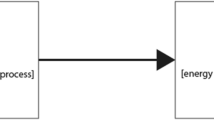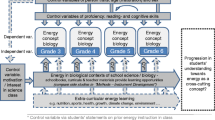Abstract
This study diagnosed the understanding about energy and biological-context energy concepts held by 90 first-year South African university biology students. In particular, students’ explanations of energy in a biological context, how energy is involved in different biological situations and whether energy is present and what types of energy are involved in diagrams depicting biological phenomena were investigated. The pencil-and-paper diagnostic test, specifically designed for this study, was used to elicit students’ understanding using test items involving biological phenomena. The results showed that many students had problems in understanding energy and energy-related concepts in the following areas: First, the majority of the students provided definitions of energy rather than the explanations they were asked to provide, and the definition could have been rote-learned. Second, although nearly all students knew the energy conservation principle (energy cannot be created or destroyed), many of them were unable to apply this concept to biological contexts. Third, many students erroneously claimed that the energy for metabolism and life processes is made available during photosynthesis in plants, during digestion in animals or that this energy comes directly from the sun. Fourth, about two thirds of the students erroneously indicated that there is no energy involved/present in inanimate objects such as a statue. The implications for the teaching and learning of energy and its related concepts and recommendations for further research are discussed.
Similar content being viewed by others
References
Baker, M. (1985). Plants and energy: A working paper of the Science Educational Research Unit. Working paper No. 225. Hamilton, New Zealand: University of Waikato.
Barak, J., Gorodetsky, M. & Chipman, D. (1997). Understanding of energy in biology, and vitalistic conceptions. International Journal of Science Education, 19(1), 21–30.
Becu-Robinault, K. & Tiberghien, A. (1998). Integrating experiments into the teaching of energy. International Journal of Science Education, 20(1), 99–114.
Bell, J. (1987). Doing your research project: A guide for first-time researchers in education and social sciences (1st ed.). Philadelphia: Open University Press.
Bliss, J. & Ogborn, J. (1985). Children’s choices of uses of energy. European Journal of Science Education, 72(2), 195–203.
Boyes, E. & Stanisstreet, M. (1991). Misconceptions in first-year undergraduate science students about energy sources for living organisms. Journal of Biological Education, 25(3), 209–213.
Bunge, M. (2000). Energy: Between physics and metaphysics. Science &Education, 9(5), 459–463.
Chiappetta, E. L., Fillman, D. A. & Sethna, G. H. (1991). Manual for procedures for conducting content analysis of science textbooks. Available from the University of Houston, Department of Curriculum and Instruction. Houston, Texas, USA.
Clerk, D. & Rutherford, M. (2000). Language as a confounding variable in the diagnosis of misconceptions. International Journal of Science Education, 22(7), 703–717.
Cohen, J. A. (1960). A coefficient agreement for nominal scales. Educational and Psychological Measurements, 20, 27–46.
Driver, R., Squires, A., Rushworth, P. & Wood-Robinson, V. (1994). Making sense of secondary science. London: Routledge.
Duit, R. (1984). Learning the energy concept in school—empirical results from the Philippines and West Germany. Physics Education, 19(2), 59–66.
Eisen, Y. & Stavy, R. (1988). Students’ understanding of photosynthesis. The American Biology Teacher, 50(4), 208–212.
Fetherston, T. (1999). Students’ constructs about energy and constructivist learning. Research in Science Education, 29(4), 515–525.
Gayford, C. G. (1986). Some aspects of the problems of teaching about energy. European Journal of Science Education, 8(4), 443–450.
Gilbert, J. K., Osborne, R. J. & Fensham, P. J. (1982). Children’s science and its consequences for teaching. Science Education, 66(4), 623–633.
Goldring, H. & Osborne, J. (1994). Students’ difficulties with energy and related concepts. Physics Education, 29(1), 26–31.
Hand, B., Gunel, M. & Ulu, C. (2009). Sequencing embedded multimodal representations in a writing to learn approach to the teaching of electricity. Journal of Research in Science Teaching, 46(3), 225–247.
Haslam, F. & Treagust, D. F. (1987). Diagnosing secondary students’ misconceptions of photosynthesis and respiration in plants using a two-tier multiple-choice instrument. Journal of Biological Education, 21(3), 203–211.
Heuvelen, A. V. & Zou, X. (2001). Multiple representations of work-energy processes. American Journal of Physics, 69(2), 184–194.
Jeevaratnam, E. G., Msiza, A. K., Case, J. M. & Fraser, D. M. (2001). Understanding of energy by first year students. In Proceedings of the Third Working Conference on Engineering Education for the 21st Century (pp. 117–122). Sheffield: Sheffield Hallam University.
Kemp, H. (1984). The concept of energy without heat or work. Physics Education, 19(5), 234–240.
Kesidou, S. & Duit, R. (1993). Students’ conceptions of the second law of thermodynamics—an interpretative study. Journal of Research in Science Teaching, 30(1), 85–106.
Kose, S. (2008). Diagnosing student misconceptions: Using drawings as a research method. World Applied Sciences Journal, 3(2), 283–293.
Kruger, C., Palacio, D. & Summers, M. (1992). Surveys of English primary teachers’ conceptions of force, energy and materials. Science Education, 76(4), 339–351.
Linjse, P. (1990). Energy between the life-world of pupils and the world of physics. Journal of Science Education, 74(1), 571–583.
Liu, X., Ebenezer, J. & Fraser, D. M. (2002). Structural characteristics of university engineering students’ conceptions of energy. Journal of Research in Science Teaching, 39(5), 423–441.
Mann, M. F. (2003). Students’ use of formal and informal knowledge about energy and the human body. Unpublished Ph.D. thesis. Australia: Curtin University of Technology.
Nicholls, G. & Ogborn, J. (1993). Dimensions of children’s conceptions of energy. International Journal of Science Education, 15(1), 73–81.
Prain, V., Tytler, R. & Peterson, S. (2009). Multiple representation in learning about evaporation. International Journal of Science Education, 31(6), 787–808.
Raven, P. H. & Johnson, G. B. (1999). Biology (5th ed.). Boston: McGraw-Hill.
Rennie, L. J. & Jarvis, T. (1995). Children’s choice of drawings to communicate their ideas about technology. Research in Science Education, 25, 239–252.
Saglam-Arslan, A. (2010). Cross-grade comparison of students’ understanding of energy concepts. Journal of Science Education and Technology, 19, 303–313.
Saglam-Arslan, A. & Kurnaz, M. A. (2009). Prospective physics teachers’ level of understanding energy, power and force concepts. Asia-Pacific Forum on Science Learning and Teaching, 10(1), Article 6.
Sanders, M. (1993). Erroneous ideas about respiration: The teacher factor. Journal of Research in Science Teaching, 30(8), 919–934.
Sanders, M. & Cramer, F. (1992). Matric biology pupils’ ideas about respiration: Implications for science teachers. South African Journal of Science, 88(11/12), 543–548.
Sanders, M. & Mokuku, T. (1994). How valid is face validity? In Proceedings of the Southern African Association for Research and Development in Mathematics and Science Education (pp. 479–489). Durban, South Africa: University of Durban-Westville.
Solomon, J. (1982). How children learn about energy or does the first law come first? School Science Review, 63(224), 415–422.
Solomon, J. (1985). Teaching the conservation of energy. Physics Education, 20(4), 165–170.
Solomon, J. (1992). Getting to know about energy in school and society. London: Falmer.
Solomon, E. P., Berg, L. R., Martin, D. W. & Villee, C. (1993). Biology (3rd ed.). New York: Saunders College.
Thomas, G. V. & Silk, A. M. J. (1990). An introduction to the psychology of children’s drawings. Hemel Hempstead, UK: Harvester Wheat Sheaf.
Trumper, R. (1990). Energy and a constructivist way of teaching. Physics Education, 25(4), 208–212.
Trumper, R. (1997). A survey of conceptions of energy of Israeli pre-service high school biology teachers. International Journal of Science Education, 19(1), 31–46.
Trumper, R. & Gorsky, P. (1993). Learning about energy: The influence of alternative frameworks, cognitive levels, and closed-mindedness. Journal of Research in Science Teaching, 30(7), 637–648.
Warren, J. (1986). At what stage should energy be taught? Physics Education, 21(3), 154–156.
Watts, D. M. (1983). Some alternative views of energy. Physics Education, 18(5), 213–217.
Author information
Authors and Affiliations
Corresponding author
Rights and permissions
About this article
Cite this article
Chabalengula, V.M., Sanders, M. & Mumba, F. DIAGNOSING STUDENTS’ UNDERSTANDING OF ENERGY AND ITS RELATED CONCEPTS IN BIOLOGICAL CONTEXT. Int J of Sci and Math Educ 10, 241–266 (2012). https://doi.org/10.1007/s10763-011-9291-2
Received:
Accepted:
Published:
Issue Date:
DOI: https://doi.org/10.1007/s10763-011-9291-2




